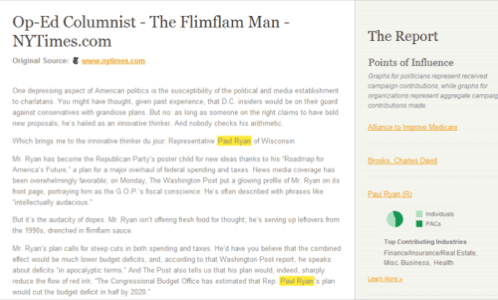This is so cool it makes me a little sick to my stomach with excitement. Well, first I should explain. I came across this service called Poligraft in our Tips folder. Tech–>government? Seemed right up my alley. So I’m checking it out. Think of this post as a kind of virtual unboxing. The promises of the service are extremely exciting and important. Let’s find out if it delivers what it promises.

“Feed in a news article, blog post or press release, and Poligraft will present you with an enhanced view of the interconnections between the people, organizations and relationships described in the piece.”
The Best Disinfectant
Poligraft, which was developed and administered by the Sunlight Foundation, allows for you to drop in either a URL or a block of text to be parsed for influence. Alternatively, you can drag a bookmarklet you can drag into your toolbar. The service stands atop TransparencyData.com, a repository of influence data.
The possibility of this service is one of illuminating hidden relationships and identifying latent patterns. As a first example, I try the last story I wrote for ReadWriteWeb, a story on the use of real-time and mobile technologies in the Kenyan elections. I thought it might answer the question, “Who or what might be influencing this article or the person writing it?” It did not.
Now I’ll try Paul Krugman’s op-ed about Paul Ryan in the New York Times. It’s domestic, and it looks like the focus is exclusively domestic with this service.

OK. As you can see by the screenshot, Poligraft identifies only the politically charged-elements – names of politicians, organizations and so forth – and provides a way to explore them. Yes. That’s nice, but I was expecting a number of things I didn’t see. I expected the publication and the writer to be included in the exploration of influence. I expected the data visualization to be operational on a much higher level. (A couple of links and a pie chart? I know it’s politics but sheesh.) Also, when I hit the “Learn more” link, I don’t. Instead, I get an “Unhandled Exception” error.
Unique Identifiers
In a blog post, Sunlight’s Ellen Miller acknowledges some of the service’s limitations, but in a somewhat disingenuous way.
“There are knotty problems you’ll find in using it, not the least of which is that without government’s help in establishing a system of unique identifiers for all those who file reports with the government, we still wrestle with lack of name standardization across various filing entities. While we’ve tried hard to sort through that, it’s far from perfect yet.”
Well, OK. That does seem to be a long-term taxonomic challenge. But if you can’t click through on a link, it seems rather like complaining about how poorly jet packs function as you wait for a stalled train.
There are a few links to examples at the bottom of the Poligraft’s home page, including a story on Politico. Those examples do look pretty good. The “Learn more” links lead to some detailed pages on something called the Influence Explorer, which is relatively more information-rich. But they’re canned examples.
Premature Deployment
This is a great idea from an important foundation. But it’s a disappointing iteration. It just doesn’t work very well, excepting the canned examples. It goes to show you, as friendly as tech has become compared to years past, it’s still a struggle to get something functional implemented if you don’t have great patience. It’s my feeling that the Sunlight Foundation should have taken longer to work out the kinks on Poligraft.
But perhaps you’ve got a different take. If so, we encourage you to register it in the comments.

















